#legendary edh plays
Explore tagged Tumblr posts
Text
The Modal Commander Servitor
An approach to a Magic: The Gathering servitor subtype. This is one of my UPG-filled personal projects.
There are many approaches to making a servitor. There are ways to advance that servitor straight to thoughtform. There are even ways to make an egregore with other magic practitioners. So that’s not what this post is about, though I will leave resources at the bottom for that [1]. This post is about using pop culture in tandem with magic to make a servitor even more powerful. I’m warning you now, we get well into the mechanical weeds of Magic: The Gathering in this one.
The thought came to me a while back in a Discord server with some magic-practicing pals. I got the idea to use my Magic: The Gathering Commander decks as modal spells (more on this term later), which then turned into ideas for making them servitors. To quote myself,
But more to the point, the idea of a Commander deck is that you have a central Guy in charge of particular Things and you typically build the deck around that, so why not treat the central Guy as a servitor empowered by the tools built into the deck (in the form of supporting cards) to accomplish a goal, and it’s empowered every time you play the deck. It’s basically outsourcing magic bullshit to eldritch monsters from between the planes, a toddler cactus person, several pirates, the gods’ most unfortunate bisexual, and a lawyer.
And then I put the idea aside for a while. Summer, my fallow period, happened. But when I came back to my practice near the start of autumn, I found myself revisiting servitor/thoughtform ideas, which prompted me to return to my old notes on Modal Commander Servitors, the Hireling Sliver Hivemind Linking Sigil System (SHILLS), and Echo Summoning. We’ll only be focusing on the first in this post.
But let’s start at the beginning. The crux of this servitor is that it is the Commander of your Commander deck, so let’s talk about the Commander format.
The Commander format (as officially known by Wizards of the Coast aka WOTC) is also called Elder Dragon Highlander or EDH. It is a casual multiplayer format with a competitive form known as cEDH. You have a deck that is 100 cards strong, and with the exception of basic lands, you can only have one copy of a card in your deck. Commander is centered around a Legendary Creature (or, more rarely, a Planeswalker) who exists in the “command zone” separate from the main deck but that still counts towards that 100-card limit. Under certain circumstances, you can have two Commanders (such as with the Partner, Partner With, Friends Forever, Choose a Background/Background, or Doctor’s Companion mechanics). You start at 40 life, and if you end up at or below 0 life, or you take 21 points of Commander damage from a single Commander, you lose the game. Your deck’s available colors are restricted only to your Commander’s color identity – every color that appears in their card, not just the ones in their initial mana cost. [2]
There’s a lot more to it than that, but for the purposes of this post, we’ll be focusing on your Commander itself rather than its format.
Depending on your approach to pop culture entities (PCEs), you may already see them as faces of existing entities (such as Karametra being a face for Demeter) or as embodiments of archetypes (such as Bertram Graywater embodying the “corrupt lawman” of the Western genre). However, these are far from the only approaches. My personal approach is “everything is already so goddamn weird, so why wouldn’t they exist”. Luckily, when creating a servitor, we’re not drawing on an existing PCE. Instead, we’re forming our energy into the shape (and sometimes personality) of one!
In the meta sense, a player of Magic: The Gathering is a planeswalker (a mortal with a spark in their soul that allows them to travel to other planes and access the magic of other planes even if they aren’t there), battles with other players are duels with other planeswalkers, and their deck represents their allies – other planeswalkers they can call in favors for aid with, creatures and allies they can summon for help, and spells and other resources they have at their disposal. [3] Therefore, your Commander is your greatest ally who can help you in this duel, one whom you can keep resummoning easier than others (as seen by the command zone being a separate zone from the graveyard). The crux of this format, in a meta sense, is that your Commander wants to help you. So why not make it into a servitor, a type of energyform, so it can help you for more than merely games?
Okay, so we’ve covered the Commander, and you presumably already read up on servitors and thoughtforms recently. But what about that other word, modal? Modal is an MTG mechanic that gives you the choice of two or more effects of a spell or ability when it’s cast or otherwise put on the stack. Modes are the different effects you may choose on a modal spell or ability. There are keywords that add onto it (escalate, entwine, and spree) that allow you to pick more or all of the options at once. [4] If you’re worried about what “the stack” is, don’t, it’s not actually relevant for what we’re doing with this servitor. Not even MTG players understand the stack. The point is, modal means options, and the only thing better than good stuff is options for good stuff.
So let’s put all of these definitions and mechanics together. A Modal Commander Servitor is an energyform stored in a Legendary Creature (or Planeswalker) card in charge of a Commander deck who uses the cards and resources in the deck (or otherwise given to them) in order to adapt to whatever you need it to do. They’re created like normal servitors and can draw on the same energy sources as normal servitors, but they can also draw power from the lands in their Commander deck. They can be empowered by both magical and in-game usage. The deck theme and archetype (such as an Otter Typal deck for Bria, Riptide Rogue or a Ninjutsu Theme deck for Yuriko, the Tiger’s Shadow [5]) also tie into and empower the Commander as both a Commander and a servitor. Sure, you can build a deck completely divorced from its Commander, but you’re kneecapping yourself and your Commander by doing so.
Let’s circle back to the Partner mechanic. It appears in multiple forms – Partner, Partner With, Friends Forever, Choose a Background and Background, and Doctor’s Companion. These abilities give you the ability to have two Commanders for your deck, with caveats.
Let’s start with Partner, the broadest form of this mechanic. Any Commander with Partner can team up with any other Commander with Partner. While most are monocolored (and there’s a colorless one that you get to choose the color of), there’s also quite a few that are dual-colored, meaning that your deck can have up to four colors with two Commanders. Of course, you could absolutely use two Partner Commanders with the same color identity to make a monocolored deck. There are definitely benefits to that approach, depending on which Commanders you choose. (Cough, Akroma, Vision of Ixidor partnered with literally anyone.)
“Partner With” is similar, but it restricts you to premade pairings. This was seen in the Battlebond set, the Ikoria: Lair of Behemoths set, and several Universes Beyond (aka, officially licensed crossover cards) sets like the Lord of the Rings Commander decks, the Doctor Who Commander decks, and the Assassin’s Creed set. “Partner With” is just a chunk of its keyword. Part of the keyword itself is the card that the Commander is...well, partnered with. “Partner With” is not the mechanic fully, because the full mechanic is “Partner With [specific card]”.
Choose a Background and its partner, the Background Enchantment subtype, were introduced in the Commander Legends: Battle for Baldur’s Gate set that came out well before Baldur’s Gate 3, leaving most of us confused about all of these named Commanders like Shadowheart and Karlach and Wyll. Backgrounds were a new way to add something to the Command zone that wasn’t necessarily a Creature or Planeswalker – instead, they’re Enchantments that boost your Commander. Even better, they work as part of the normal Commander deck, so they can still boost your Modal Commander Servitor even if they’re not in charge of it!
Friends Forever is a type of Partner originally tied to the Stranger Things Secret Lair cards that was brought in-universe with the Innistrad re-workings of those characters into more lore-accurate cards; any card with Friends Forever can team up with any other card with Friends Forever, but this one can even give you access to all five colors of mana.
Doctor’s Companion is a Partner keyword from the Doctor Who Commander decks that allows the cards with that keyword to partner with any Commander who has the subtype line “Time Lord Doctor”. My coworker, who is way more into Doctor Who than I am but knows very little about Magic: The Gathering, was absolutely giddy when she saw how that worked.
I understand that this is a lot, so let’s circle back to the primary point: using Partner Commanders means that you essentially have two Commanders to try and deal with in a Modal Commander Servitor context. I can think of a few ways to handle this, personally. One way is to just have two servitors and allow them to work together or separately to accomplish goals. Another is to treat them as two sides of the same servitor, drawing on one side at a time. A third that I can think of is to just address them as one unit, since that’s what your Commander deck is – a fusion of their two abilities to create a stronger whole.
There are also the Companions to consider. The Companion mechanic debuted in Ikoria: Lair of Behemoths in 2020, and it was panned as a mechanic. Even being reworked for the Multiverse Legends in 2023 reprint didn’t help the mechanic much. Notably, Lutri, the Spellchaser was banned in Commander the moment it was previewed [6] and Yorion, Sky Nomad can’t be used in Commander because it requires your deck to have more than the 100-card limit the format has. [7] But the other eight Companions are able to function as Companions (provided you have that Rule 0 talk with your pod about allowing a sideboard) within the constraints of the Commander format [8], thus giving you a 101st card and, potentially, an additional servitor. While they may not necessarily be an additional Modal Commander Servitor, they can be crafted as an additional, lesser servitor to aid your Modal Commander Servitor.
And no, you can’t use it as both a Commander and a Companion. The “only one card” rule still applies, so you have to choose one. However, provided that both of your Commanders meet the Companion’s requirements, you can absolutely have two Commanders and a Companion.
Do you see what I mean about getting into the weeds?
So what about when you’re done with your Modal Commander Servitor? My approach is to use a built-in “kill switch” to dissolve the servitor and, since this is tied to a specific Commander deck, to dismantle the deck and cleanse the Commander card. Simple and to the point, because I like simple and to the point.
I also made it easy to activate and dismiss my Modal Commander Servitor. I build all of my energyforms with activation phrases that will pull them out of “hibernation” and dismissal phrases that send them back to it. This allows them to rest and regain energy without having to be actively used. I used this same method and theory for my own Modal Commander Servitor.
I am also in a pod that believes in using every card we own, so even if a card is officially banned in Commander by the Commander Rules Committee (before they recently disbanded) or Wizards of the Coast, we still use them. (I feel the need to mention that I primarily play against my mother, who was a Magic: The Gathering player from the early days and does not believe in mercy.) Naturally, if you play with a specific group, you can talk to them about in-pod bans and allowances, but if you play against random people, it’s probably best to listen to the existing banlist. Of course, with WOTC in charge of the bans now, there’s going to be a whole power scaling thing... Lowkey, this format is kind of a mess right now because people lost their ever-loving minds recently. [9] But this is a post about pop culture occultism, not...that mess, so let’s move on!
For the rest of this post, let’s step through a theoretical Modal Commander Servitor. We’ll pick Yorion, Sky Nomad [7] because I feel bad for it. Although it can’t be a Companion, it’s still entirely legal as a Commander! Yorion is a White and Blue Legendary Bird Serpent for five mana, getting up into the pricier side of a Commander. It has four power and five toughness, meaning it can hit your opponents decently hard and take a pretty big hit. It has the Flying keyword, meaning that it can only be blocked by creatures with the Flying and/or Reach keywords. When it enters the battlefield, you get to exile any number of other, nonland permanents that you both own and control; they then come back to the battlefield at the beginning of your next end step. This is commonly referred to in MTG as “blinking”.
So this is pretty good, at least to me. You can bring it into the battlefield and exile any number of things that also have “enters the battlefield” triggers to get them to pop off once more. And looking at Yorion’s EDHRec page, a lot of people had the same idea. As of writing this, there are over one thousand decks on EDHRec that focus around blinking with Yorion at the helm. But blinking isn’t the only thing Yorion can do. Plenty of deck themes also feature cantrips (cards that draw you cards in addition to doing something else), those damned Persistent Petitioners (who can make your opponents mill their deck until they die from running out of cards), cloning, Flying, and so on, though none of them have nearly the number of Yorion decks that blinking does. Personally, I’d build a Bird deck, because I’m predictable and like Typal decks. I would add cards like Skycat Sovereign, Watcher of the Spheres, Favorable Winds, and other cards meant to boost Birds or Flying creatures. Ultimately, I would focus on making this a functional Commander deck first and foremost, because I’m not going to keep a deck around if it sucks ass. That kind of defeats the point of the Modal Commander Servitor – in order to make it more powerful, you need to use it for both kinds of magic.
So that’s the “Commander” part figured out. Let’s shift focus to the “Servitor” section. I have a fairly quick yet simultaneously detailed approach to making servitors. [10] The important things to emphasize when building this Modal Commander Servitor are to name the servitor for the card (including any epithets or surnames on the card you’re using), to give them the ability to draw on the cards/resources in their Commander deck, and to specify that your Modal Commander Servitor is just that when you are speaking it into existence. Give them the ability to adapt and whatnot.
So now we’ve got a Modal Commander Servitor. Personally, I would focus on pouring energy into it and giving it simple tasks at first so it can get its feet under it. Being spontaneously brought into existence is disorienting, even for things that can’t think for themselves and aren’t sentient, so I give my servitors a chance to exist and hang out in their “dismissed”/hibernation state so they can get used to existing.
Now, let’s talk about potential specificity. Even though I keep my Modal Commander Servitors extremely vague and adaptable, you can outline the particular modes you need them to function in more specifically. For example, Yorion can be given different “modes” focusing on categories of magic typically aligned with White and Blue, such as protection, scouting, travel, and elemental air and water. This can help if you want the Modal Commander Servitor to be more specific than “do whatever”. If you follow the “all entities are ultimately facets of a bigger entity” approach, you could have Yorion channel parts of the Bird overspirit or the Serpent overspirit, if that’s your spiritual cup of tea.
Ultimately, the point of the Modal Commander Servitor is adaptation and flexibility. Sometimes, you just need to outsource a problem and you don’t have the time to make a more specific Guy for it, but if you already have one of these handy, you can just point them at the issue and wait to see what happens.
I hope you enjoyed this post! It got...pretty long, but I think that’s ultimately for the best, since it enabled me to pack more detail in. If you end up doing this, please let me know what you do and how it goes! I’m eager to see what other people experience with this deeply UPG-based approach to servitor creation and usage.
Citations, Resources, And Further Reading
[1] “Jasper’s Servitor/Thoughtform Resource Post”, compiled on Tumblr by jasper-pagan-witch: https://jasper-pagan-witch.tumblr.com/post/762988504970100736/jaspers-servitorthoughtform-resource-post
[2] “Commander (format)” on the MTG wiki, compiled by Fandom users, through a Breezewiki mirror: https://antifandom.com/mtg/wiki/Commander_(format)
[3] “Planeswalker” on the MTG wiki, compiled by Fandom users, through a Breezewiki mirror: https://antifandom.com/mtg/wiki/Planeswalker
[4] “Modal” on the MTG wiki, compiled by Fandom users, through a Breezewiki mirror: https://antifandom.com/mtg/wiki/Modal
[5] “Bria, Riptide Rogue (Commander) – Otter” and “Yuriko, the Tiger’s Shadow (Commander) – Ninjutsu” on EDHRec: https://edhrec.com/commanders/bria-riptide-rogue/otter and https://edhrec.com/commanders/yuriko-the-tigers-shadow/ninjutsu
[6] “Lutri” on the MTG wiki, compiled by Fandom users, through a Breezewiki mirror: https://antifandom.com/mtg/wiki/Lutri
[7] “Yorion, Sky Nomad” on Scryfall: https://scryfall.com/card/mul/64/yorion-sky-nomad
[8] “All Companions” on EDHRec: https://edhrec.com/companions
[9] “On the Future of Commander” on the official Magic: The Gathering website, by Wizards of the Coast: https://magic.wizards.com/en/news/announcements/on-the-future-of-commander
[10] “Entity Creation Worksheet” adapted on Tumblr by jasper-pagan-witch: https://jasper-grimoire.tumblr.com/post/763362895377694720
Condensed Chaos: an introduction to chaos magic by Phil Hine: A good beginner primer on chaos magic, with a fairly extensive chapter on servitors/thoughtforms and a willingness to explain things that I just gloss over and build red string boards about.
Magickal Servitors: Create Your Own Spirits to Attract Pleasure, Power and Prosperity by Damon Brand: A very thorough book on servitor creation, though not necessarily from a chaos magic lens. I found it very funny to read how much the author was frothing at the mouth about chaos magic. Yet, it’s still hands-down the best book dedicated entirely to servitor creation that I’ve read thus far.
EDHRec, a website for comparing Commanders and seeing the most commonly used cards in particular decks: https://edhrec.com/
Scryfall, an MTG card searching database: https://scryfall.com/
#jasper post#pop culture#pop culture magic#pop culture magick#pop culture witch#pop culture witchcraft#magic the gathering#mtg magic#mtg magick#mtg witch#mtg witchcraft#servitor#thoughtforms#energy work#long post#personal
30 notes
·
View notes
Note
Opinion on Ral Zarek now being an Otter in both meanings of the word?

rant time i talked about this on Twitter a bit yesterday but it's so fucking stupid. like it's kinda cute that Bloomburrow has the kingdom hearts lion king world "if you go here you're an animal while you're here" thing, but also the only thing we were really told about Bloomburrow leading up to it was "there will be no humans on the plane". so we're all like oh shit, cool, sounds like it's gonna be its own unique thing without a bunch of Dudes You Know in it since there's no humans in it, right? we can finally escape the cycle of banal, tropey sets that are mostly just "Characters From Magic's History Dress Up In Costumes" (MKM, Cowpokez, NEO, Capenna) but nope. of course not. if you planeswalk/omenpath to bloomburrow, you turn into a furry! now watch them sell secret lair packs of fur-tfed planeswalkers, because of course every set needs to be a vehicle for a bunch of stupid gimmicky Products™️ they can sell to gamers with extremely loose wallets

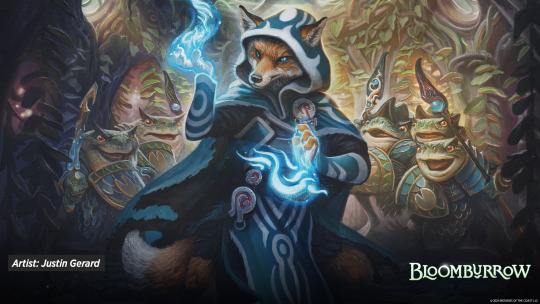
oh, yeah, and alongside this announcement was that they're cutting off printing of portuguese cards. it's not the Biggest deal since I've heard firsthand in non-English speaking countries that they usually just end up using the English cards anyways (gee I wonder if this has anything to do with the globalization of American culture lol no problems there). but they only decided to cut off the printing of portuguese (and simplified chinese) cards because they're facing a 2% drop in profits this year... because of all the stupid royalty fees they're paying on their dumbass Universes Beyond crossover bullshit lol

i've loved Magic since i started playing in high school, but as of late that love has been waning a good bit. the game is so bogged down by corporate product shilling bullshit. every card needs 900 alternate arts. 900 alternate borders. every set needs a hideous alternate card treatment. every set needs 56 different kinds of booster packs. no more Block-format releases, no more core sets, just products, products, products, products.

i used to be a big fan of Commander/EDH, but ever since it really caught on and Wizards/Hasbro decided "well, this is the most popular gamemode, we now need to design the entire game around it" and it kinda completely ruined commander imo. what was once a gamemode about running weird, niche interactions and building something with a unique flavor or playstyle now boils down to "well, just pick one of the 92849634796782435678 legendary creatures they've been printing for the past few years and run all these extremely pushed commander staples they keep printing" and it just ain't fun anymore. gotta sit down at the table and look at entire Doctor Who decks and Transformers cards and Tomb Raider cards and etc etc etc etc etc etc etc etc. Commander tables are just fucking billboards now lmao
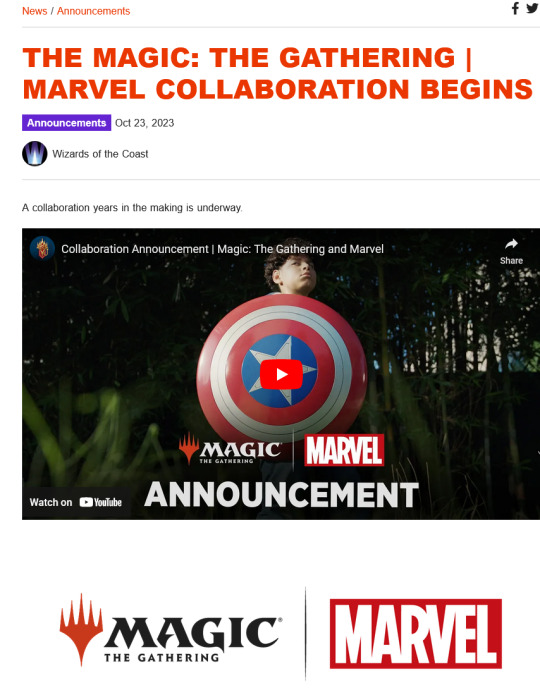
it's very clear WOTC/Hasbro has no idea what to do now that they did the Giant Multiverse-Ending Threat of the Phyrexians in All Will Be One. much like the marvel movie franchise which MTG has been so emulating for years now (AND HAS EVEN SIGNED A FUCKING CROSSOVER DEAL WITH AS OF LAST YEAR, SEE YOU IN 2025 THANOS COMMANDER DECK), we're at the period where they're just throwing shit at the wall and seeing what sticks, twiddling their thumbs with these boring, tropey sets, all the while drowning players in a deluge of alternate arts, secret lairs, crossovers, etc. a common complaint among magic's playerbase is that nowadays they're literally selling too much shit. preview/teasers season for one set will immediately be followed by previews and teasers for another set. there's no time for anything to breathe it's just buy buy buy buy buy buy buy buy buy buy buy buy buy buy buy.
youtube
anyways stop giving hasbro money, print proxies and play magic for free :)
#don't forget final fantasy cards coming next year!#askmi#sorry for busting out my rantsona voice#like all other things mtg is ruined by money
57 notes
·
View notes
Note
I play Magic daily, and respectfully, I cannot recall the last time the Legendary drawback was relevant to me. EDH is singleton, so it rarely matters there. In Constructed, you build your deck, so you build with the Legend rule in mind. In Limited, you rarely have multiple copies of a Legend at all, even at uncommon. So, I'll reiterate, it feels to me that 90% of the time, the drawback isn't relevant. I know you may disagree, but I'd still like to hear more about WotC's perspective on the shift.
When you play non-singleton formats, do you play less than four copies of legendary creatures? If you do, then it’s mechanically impacting your play. Also, if we want you to play multiples, we specifically don’t make it legendary. Third, if we put them at uncommon, we have to adjust the set to accommodate for it, so the legendary drawback matters less.
138 notes
·
View notes
Text
Modern Horizons 3 - Commander Spoilers as of 5/9
Here's all the cool cards of MH3! This will include powerful cards that I like or dislike and cool cards that I like, even if they aren't very powerful. Also, I'm primarily an EDH player, so I'm not coming at this from a modern player's perspective. Anyways, without further ado, the commanders of MH3:
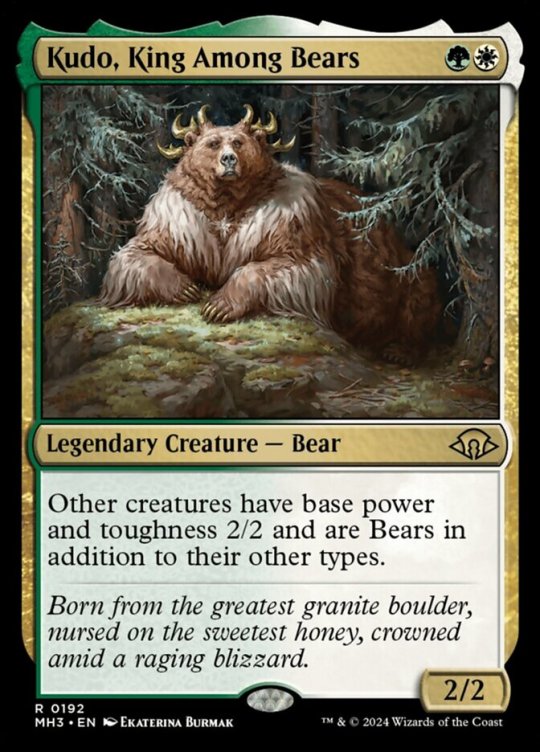
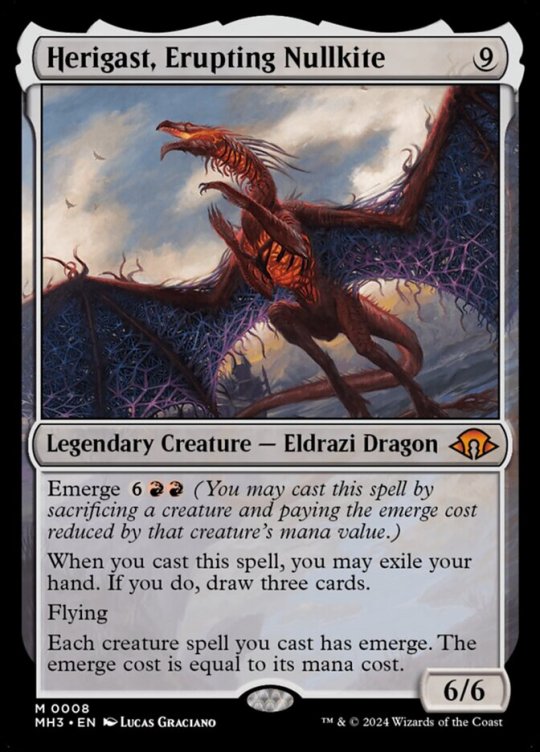

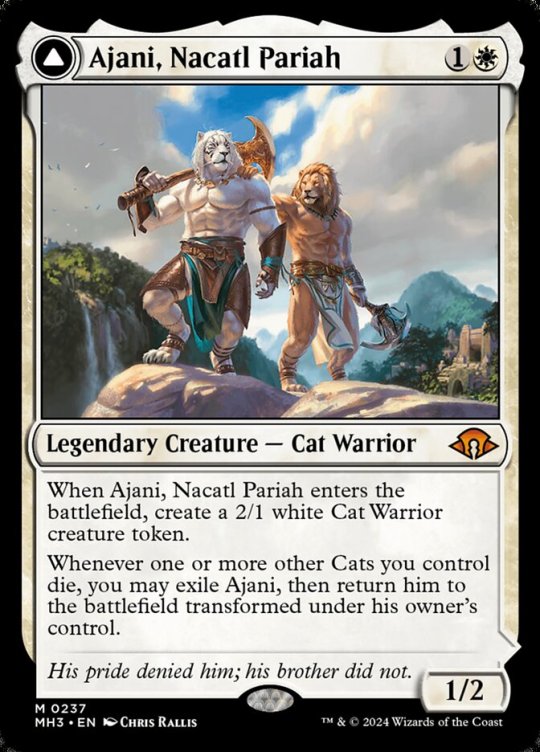
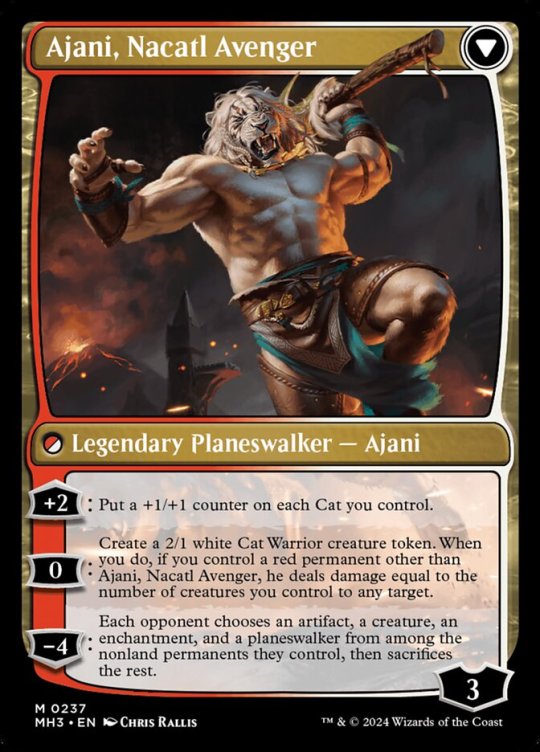
Kudo, King among Bears.
For anyone who witnessed my rant on main that made me make this blog, you know my opinions. However, if you didn't see that rant just know it's a BS card. Too cheap (2 CMC? Really?) and too powerful. Combos way to well with Ayula, making anything you want to be a bear and removing any kind of creativity you could put in an Ayula deck. Now you just find big blocks of text and Kudo tells Ayula that no, actually, that was a bear not an Eldrazi. Kudo will also combo WAY to well with Elesh Norn Grand Cenobite, board wiping any creatures your opponents play if they can't put counters on them or banner effects as they enter the battlefield. Kudo also combos too well with other STAX and hatebear pieces for me to like him. It's a cool card in concept, but to powerful in my opinion.
Herigast, Erupting Nullkite.
Cool card! I love the concept of giving your stuff emerge, because emerge is a really cool mechanic! It does nothing if you sac a token, but if you get rid of a big mana piece you get a significant discount. It's a cost reduction mechanic that, on its own, is actually fair. That being said, I wish it had been in Rakdos rather than mono red, because it would've given more sacrifice synergies with cards like Mahad, Juri, Rakdos (OTJ version), and others. It would've also given access to al manner of graveyard shenanigans. But I still like the card, even if I don't agree with the colors it was printed in.
Phelia, Exuberant Shepard.
Not sure why it has flash tbh. Also didn't think we needed another mono white flicker commander, but here we are. It's a pretty fair card overall, maybe even weak. It only gets counters from cards that it flickered, not from any flickered card. As well, it doesn't have anything like trample or fist strike, so its harder to make this into a commander damage card. And then outside of commander I don't think it really does anything. Could be wrong about that though, so don't quote me on it.
Ajani, Nactal Pariah // Ajani, Nactal Avenger.
Pretty cool card and excellent flavor. He might be too powerful though. He's cheap and pretty easy to flip, and you can use his ultimate pretty fast. And that ultimate is BRUTAL. A near full wipe on turn 3 or 4 is quite the prospect to be facing down. And his +2 being a counter rather than a banner effecct until eot or end of next turn. Still though, its in Boros, so maybe it won;t be the most broken thing ever. Could be wrong about that though.
Personally, if I was desigining this Ajani, I would've made it a {2}{w} rather than {1}{w}, and had the token it creates be a legendary token with his brother's name that gives Ajani +1/+1, becuase that theming goes along well with the flavor text. His transform condition is perfect, it's right on theme, so no changes there. Then as far as his planeswalker side goes, make his +2 a +1 instead, have it be Cats you control get +1/+1 until eot. I think that balances out his ultimate and gives another player more time to respond. Then his 0 ability is also good, because it encourages the player to balance the amount of red and white in their deck.
Overall the four new commanders are getting a solid B from me. Herigast is dope. Kudo is too OP. Ajani needs a minor nerf and then he's a really cool card. Phelia just seems useless.
7 notes
·
View notes
Text
heres the thing about color balance in commander. mtg was created in 1993. cards stretching back to 1993 are legal in edh. wotc did not have 4-player 40 life 100 card singleton based around a legendary creature who you (nearly) always have access to with decks that are color-restricted to only use the colors present on that legendary creature card in mind when they printed ancestral recall and healing salve. why the fuck would it be balanced? wotc only started creating cards specifically for commander in 2011. yes it has had time to catch up, but cards in that 18 year gap are still legal. they didnt wait until 2011 to create the color pie, so no, they didnt base red's color identity around being able to deal 120 damage every game. they based red aggro on 20. for 18 years. mono white fucks my ass every day drawing 1 card per turn in the format i play most. there is nothing inherently bad about these colors
white and red have been catching up in recent years. im sorry not every card spanning back to 1993 is balanced for a fan-made format with wildly different rules that were inherently less favorable to certain slices of the color pie
#wotc looooves making cards with edh in mind that will obliterate other formats and make no dent on edh#mtg
21 notes
·
View notes
Text
With Commander Masters dropping I thought it’d be fun to dig deep and go back to when I first started playing and some commanders people ran.
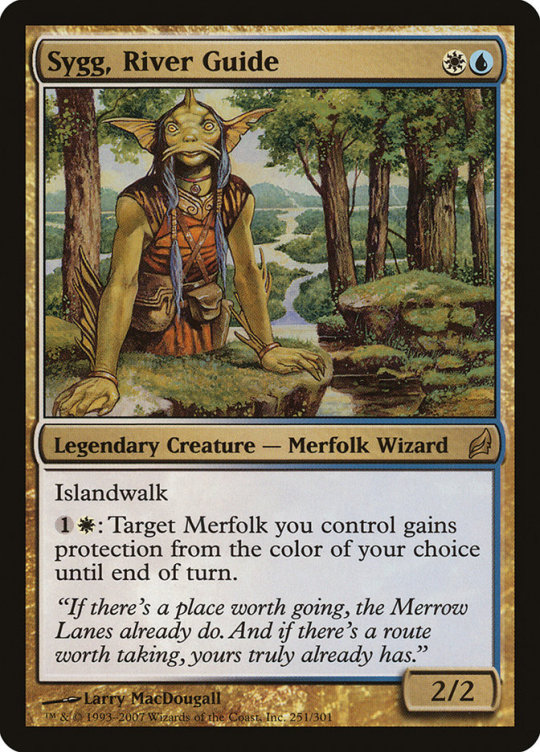
You probably remember Sygg River Cutthroat, the dimir legendary from the rogue deck. Here’s his more pleasant self! A merfolk saboteurs deck in azorius. This means you find lots of ways to get combat damage for value, with merfolk the easiest way is make someones land an island and start swinging. Protection helps with combat, stops targeting, and prevents red board wipes!

Heroic was in the original Theros block, a mechanic that rewards you for casting spells that target a creature. This is a deck that turns that one spell into an anthem and trample for your field! The trample enabling is especially juicy, and there’s a number of relevant cards in boros like Boros Charm and Temur Battle Rage.

Lazav 1.0 is probably my favorite commander when it comes to milling. He’s entirely fair: he’s only as strong as what your opponents run and he punishes building with bomb mythics over synergy. Discard, kill, and mill all trigger him. Retaining Hexproof is nutty too when you get something indestructible. He’s a fantastic minigame that continues as you forward your mill.
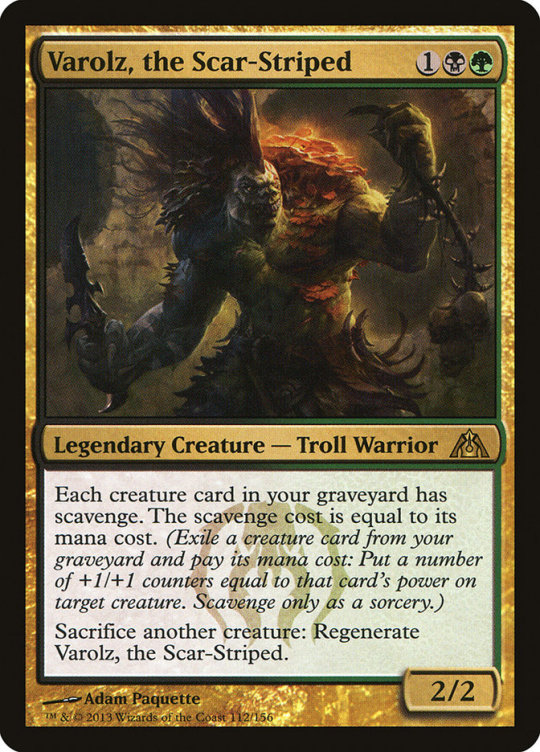
Varolz is a card I can never remember the spelling of. He uses a mechanic called Scavenge: exile a creature card from your gy and pay its cost, put that many +1/+1 counters on your dude. There are tons of low mana creatures with stipulations like Death’s Shadow and Lupine Prototype that fit the bill, giving you a super unique counters build. His sacrifice for regenerate means nothing short of exile, -X/-X, or bounce is gonna remove him all tied up in a useful 3 drop.
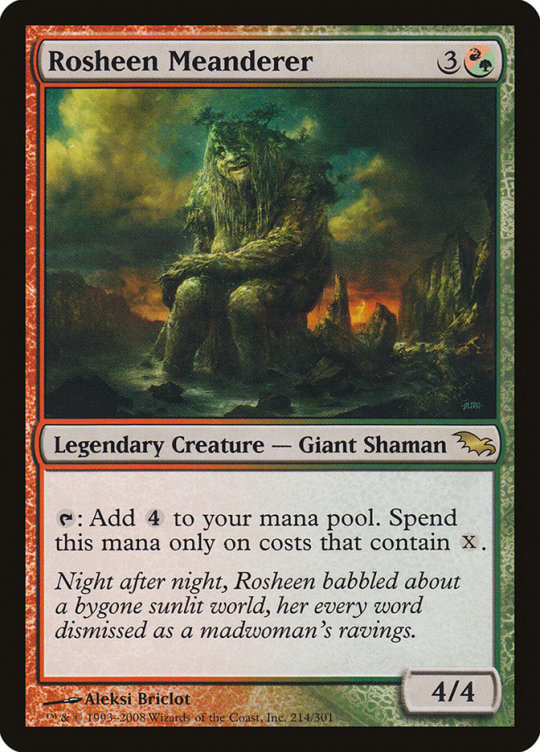
Rosheen Meanderer funnee. You have green and can go absolutely nutso with ramp letting you go absolutely nutso with your X costing spells. And having a commander give you 4 extra mana towards them can do a whole lot. There is the sultai hydra X cost commander from Ikoria, but this lets you use burn as a strategy.
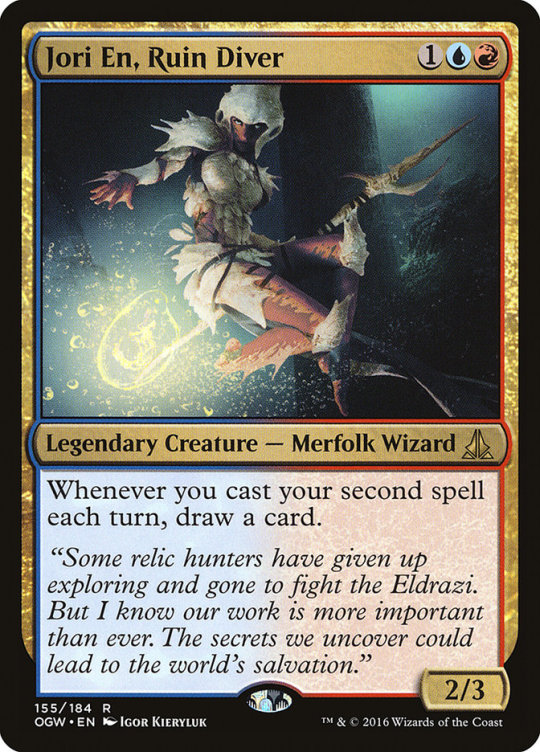
Jori En is the best izzet commander no one uses. The idea is simple: cast two spells a turn for a card. Jori En draws me So Many Cards each game its unbelievable. I’m casting two spells on my turn, on your turn, on the next turn. This is letting Talrand make a shitton of drakes. Lots of token generation in this build, its very fun.
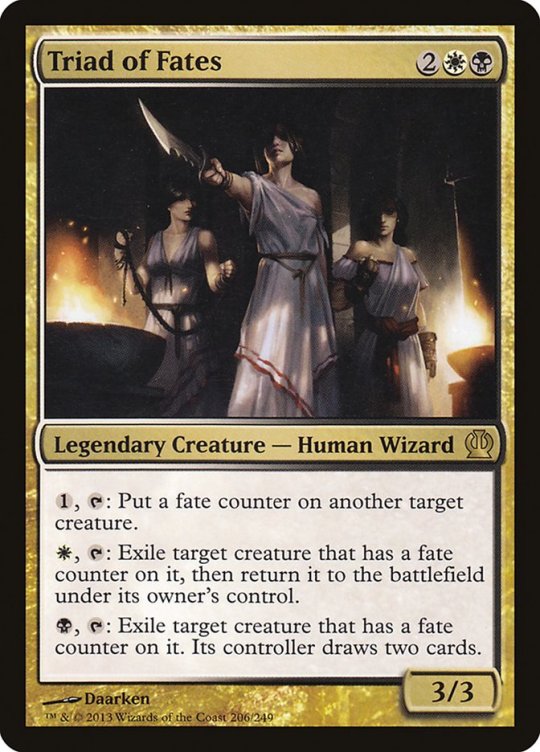
Orzhov is usually known for its sacrifice but what about its flicker? Triad of Fates allows you to start fate countering yours and your opponents stuff, its slow so you’ll need untap effects to get good use out of it. Their second ability allows you to remove your opponents’ stuff or draw off your own!
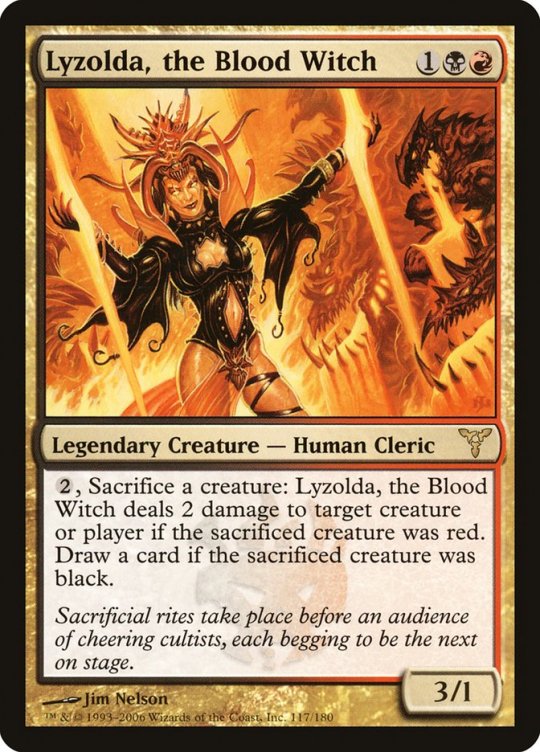
Lyzolda allows you a sac outlet in the command zone and draws off your sacrifices if they have black. That’s in conjunction to the test of your synergy. The 2 damage on red sac isn’t bad either, using it on small drops is great, and equipping her with Basilisk Collar for deathtouch and lifelink goes a long way.
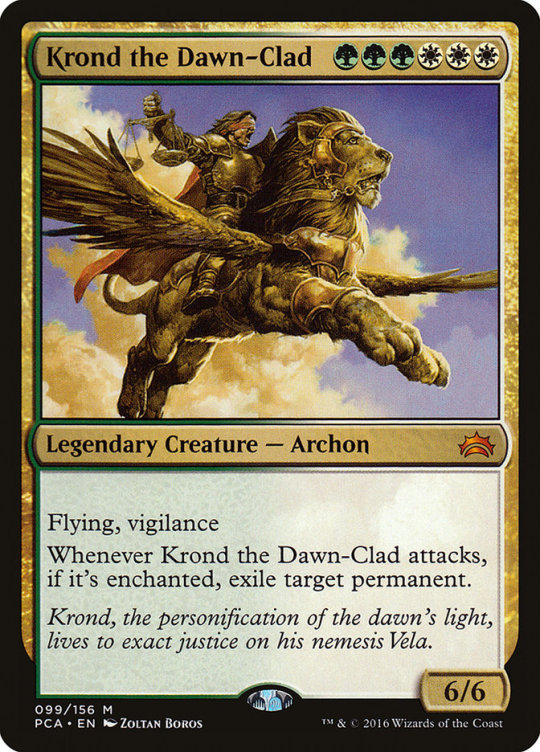
In the before days wotc used to print lots of different kinds of products besides standard, edh, and masters sets. Krond comes from the second planechase set, a selesnya auras build. I love that mana cost, its so juicy. Something that 100% supports devotion tech in either color. Vigilance also makes him a great mid to late game drop and that you don’t have to connect, you just have to swing to exile is huge. Great base stats and keywords before enchanting makes him a monster for voltron or in an auras build.

One of the best yet simplest simic commanders, Zegana becomes one more bigger than your highest power creature then you draw that many cards. A perfect play after you’ve established your field and ran out of hand. Works for counters, sea monsters, general ramp builds, Zegana provides you with a beater and gets you back in the game with card draw.
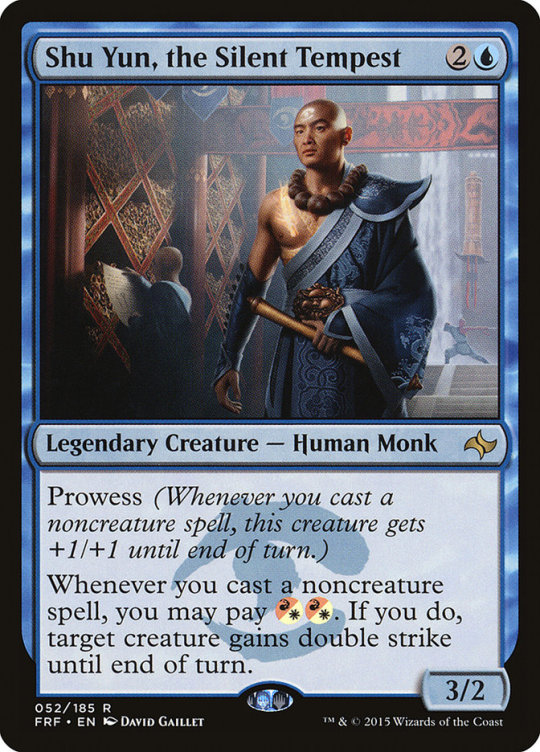
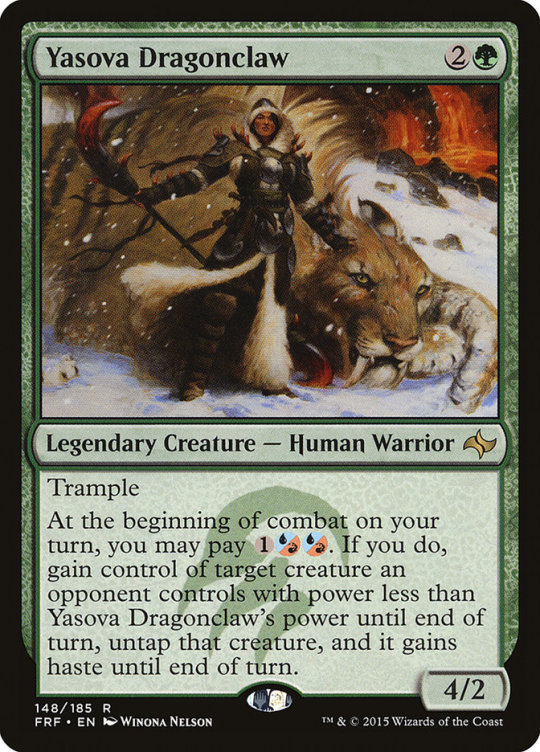
While I wanted to stay in two color there’s two special mentions I wanted to touch on. Everyone knows Alesha and Tasigur but they were two cards of a cycle. Shu Yun pairs so well with new Narset, after Narset free casts you pay two to give something double strike. If you pick Shu Yun thats two prowess triggers and he’s a 6/4 double striker.
Yasova has interesting tech for power matters. For 3 you can steal a smaller dude for combat. Yasova herself has trample making buffing her worthwhile, and in temur colors this can be turned around into a fun power matter strategy with buffs, doublers, etc.
16 notes
·
View notes
Note
Karlov Manor was a pretty fun set for sealed. The new booster pack model is pretty great. I ended up with 5 rare dual lands. Rares are practically “Super uncommons” now but I don’t mind. It puts cards in people’s hands for less money, packaging waste, and production waste on draft chaff. I’d like to see them do a master set like that with a decent roster of reprints, priced less than any double masters set.
glad to hear you enjoyed drafting it! i havent touched the newest set(s) like at all, havent played any EDH in a few months at this point. any good uncommon legendaries get printed? or any particularly neat commons? i basically only play pauper and pauper commander now
3 notes
·
View notes
Text
How to build Commander EDH in 2010
It's summer of 2010 and you're looking for a Magic format to play besides Standard and Extended, so you, like Magic players everywhere, are building your first Elder Dragon Highlander deck. The EDH Rules Committee has recently banned Channel, Staff of Domination and Tolarian Academy—Rofellos too, but only as a general.
Choosing your Commander General
While you *can* use a mono-color legendary creature as a general, most people build around a multicolored legendary creature so they can have access to a greater range of effects. For instance, Kiki-Jiki, Mirror Breaker looks like a cool creature to build around, but your friend plays a Zur the Enchanter deck and always gets Solitary Confinement out—Gambling for Capricious Efreet seems like a really unreliable way to deal with that enchantment. Instead, you'll probably choose one of the 3-color dragons from Planar Chaos, or a 3-color legendary creature from the Shards of Alara block as your general. There are some 5-color options, but most of them care about specific creature types (3 Sliver legends!) and while there aren't any 4-color legends, some people are okay with letting people use one of the five Nephilims as a general.
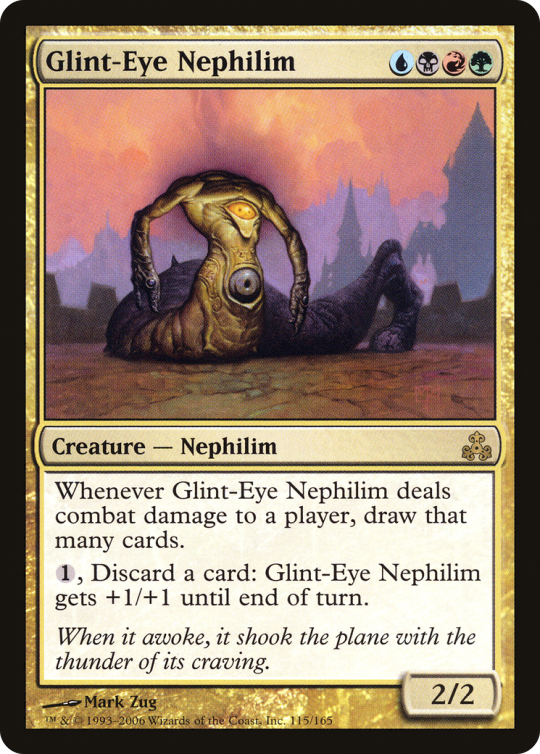
Building around your general is important, but make sure that your deck can also function without it! People like to play "tuck" effects that will put your general on the bottom of your library or shuffle it in: Oblation, Proteus Staff, and Hinder are all popular cards in the format.

How Many Lands? Curve Considerations?
Most EDH playgroups use the Partial Paris mulligan: that means you can keep some of the cards in your initial hand and put the others on the bottom, then draw back up to seven. You can repeat that as many times as you need to, but every time after the first you draw one fewer card. The Partial Paris mulligan means you can regularly get starting hands with 4–5 mana sources while only having around 30 lands in the deck in total. As far as the mana curve is concerned—most 60-card decks have a curve that, depending on the format, center on two or three mana. But in EDH, games go long and players have a LOT of life, so decks are jammed full of 6, 7 and 8-mana cards that have big effects; expect to see haymakers like Insurrection, Tooth and Nail, and Titanic Ultimatum. Consequently, most EDH decks have mana curves that center on 3 or 4 mana.
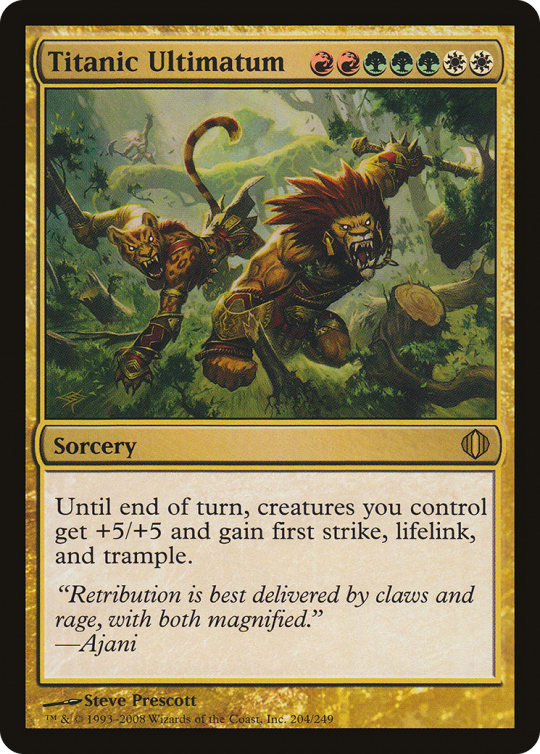
Color Fixing
If you're a long-time Magic player, you might have some original dual lands gathering dust in your closet somewhere—unless you play Legacy or Vintage you probably haven't had any use for them—grab those! If you don't have them, don't worry about it too much—in a 40-life format the shocklands are basically equivalent, and those only range from $10–30 whereas the original duals range approximately $30–80 each for their cheapest printings (there's no good reason to spend $80 on a white-bordered Volcanic Island when you can get a Steam Vents for $25). What's important is that you have at least some lands with multiple basic land types so that you can grab exactly what you need with fetchlands. The painlands also benefit from the higher life total (as does City of Brass). The Shadowmoor/Eventide filterlands are a great option and a little cheaper now that they've rotated out of Standard (same for Reflecting Pool). The original filterlands from Odyssey are slightly worse, but still worth playing. At the moment there are only the allied color pairs—but WoTC might finish the cycle sometime in the next few years (no way they'd wait 14 years to do that).

And in a multiplayer game with all these multicolored generals being played, Exotic Orchard is likely to be able to tap for all of your colors. (Keep in mind that since it's 2010 you won't be able to produce colors outside your general's color identity—so if you're playing a Lord Tresserhorn deck and you Clone your opponent's Jenara, Asura of War, for example, you still won't be able to make white mana with Exotic Orchard to activate the ability.) All that said, if you can't afford to spend $150 or more on your mana base, there are some budget options. The Ravnican bouncelands (aka Karoo lands) are great in EDH—they help fix your colors and essentially put an extra land in your hand. Terramorphic Expanse and its new sister Evolving Wilds can be used to find whichever basic land you need. For 3-color "shard" decks, there's the uncommon land cycle from Shards of Alara; the vivid lands from Lorwyn can also be used in a pinch, as can the refuge lands from Zendikar. If you're on a tight budget, you might find it easier to build a shard color combination than a wedge, since there are more allied-color lands than enemy-color lands.
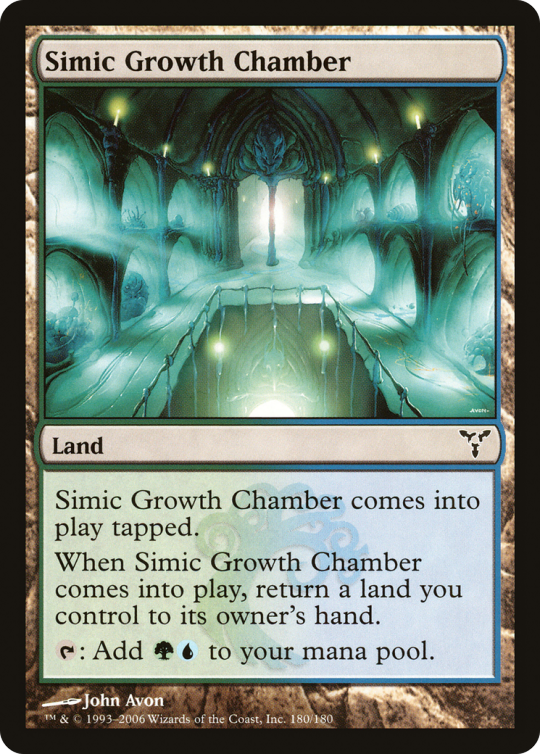
Ramp
When it comes to ramping your mana, if your general has green in its color identity, you're on easy street. Cards that destroy lands en-masse like Armageddon are considered taboo by most EDH playgroups, so cards that get extra lands into play are pretty surefire ways to ramp. Kodama's Reach (and its new non-arcane counterpart Cultivate), Explosive Vegetation and Skyshroud Claim are all gold-standard ramp cards. Land auras like Wild Growth, Fertile Ground and Overgrowth can be effective too, but they leave you vulnerable to Strip Mine and Avalanche Riders. If you don't have access to green, you're going to have to rely on mana rocks for ramp effects. Sol Ring is definitely the best option here; you can pick up a white-bordered one for around $5-10 (frankly, you should get ones for your green decks too). Its cousin Mana Crypt, on the other hand, is in the vicinity of $100 a pop—firmly outside most players' budgets. In between those extremes, we've got Grim Monolith, Mana Vault, and Gilded Lotus. Thran Dynamo, Worn Powerstone and Basalt Monolith are uncommons and each under $5.
Mana rocks can also help fix your colors. Coalition Relic is an all-star in decks with a lot of colors. The Signets, the Talismans (allied colors only), and Fellwar Stone can help shore up your mana base.

Not a mana rock—but still a form of colorless ramp—is Solemn Simulacrum (aka Sad Robot); an excellent early game play, the robot gets you an extra land when it enters and draws a card when it inevitably dies.
Card Draw
Drawing more than the standard one-card-per-turn is really important in EDH. Multiplayer games are battles of attrition, and you're going to want to make sure you always have gas in the tank. As you may know, some colors are better at this than others: blue is a natural at drawing cards, and black is no slouch either. Green has some ways to draw cards, but they (mostly) depend on having either a lot of creatures, one large creature, or having lots of large creatures.
White and red, however, have... not much to speak of. Mesa Enchantress and... Kor Spiritdancer, I guess, in white. Red's got... Browbeat? (Don't play Browbeat.) Card draw's just not in that part of the color pie; if your general doesn't have access to blue, black or green, you'll again have to turn to artifacts to fill in the cracks. Mind's Eye is a good way to draw a lot of cards, if you have the mana to spend. If your deck can make a lot of X/1 creatures, Skullclamp is there to turn them into new cards. If your creatures have flying, unblockable or double strike, Mask of Memory and Sword of Fire and Ice will help. If your deck gains lots of life, try Well of Lost Dreams.
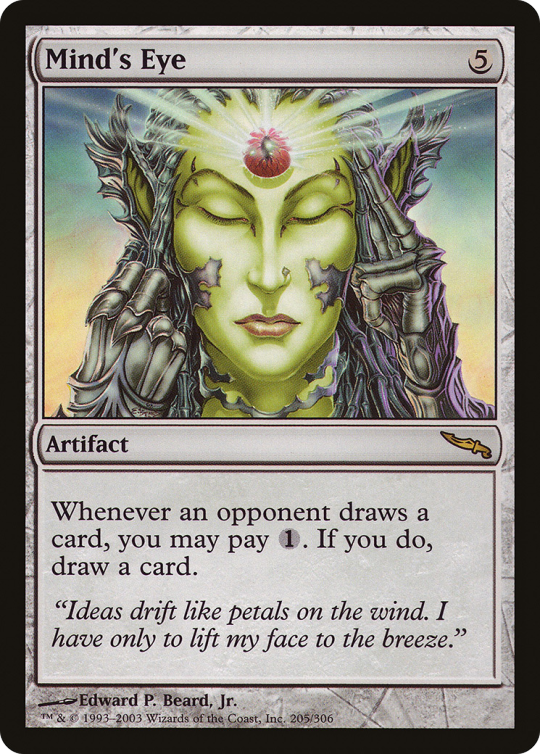
In truth, those artifacts aren't enough to fill the gaps. Unless you're looking for a real uphill deckbuilding challenge, it's best to avoid generals that don't have any blue, black or green in their color identity.
Removal and Board Wipes
Make sure to include a handful of removal spells and board wipes to keep your opponents in check. The goal is to have some response to their most powerful move—Nature's Claim their Beastmaster Ascension before they attack with 10 creatures—Swords to Plowshares their Rafiq that's attacking for 22—Counterspell their Time Stretch, etc.
Be on the lookout for removal spells that remove two or more things (artifacts and enchantments especially) at once: Return to Dust, Hull Breach, Decimate, Aura Shards, etc. Since most board wipes only destroy creatures, it's crucial to make sure opposing Rhystic Studies and Doubling Seasons don't stick around for the whole game. (Speaking of Rhystic Study—if you or your LGS have got any old boxes of Prophecy bulk, check for copies of this 3 CMC common. It might look underwhelming, but you'll be shocked at how many cards this can draw you in a four or five-person game!)

Speaking of board wipes—EDH games are long and full of ups and downs, and if you want a chance to make a comeback when you've fallen behind, you'll want a board wipe to even the playing field.
White, of course, has the greatest variety of board wipes: Wrath of God and Day of Judgment are clean and efficient; Hour of Reckoning, Mass Calcify, and Soulscour can be near-one-sided board wipes in the right decks; and Martial Coup can leave behind a batch of tokens. Austere Command is probably the strongest due to its modality, but don't overlook Rout either—casting a wrath at instant speed is likely to catch other players off-guard. Black is the next best color at wiping the board. Damnation costs a pretty penny right now, but is the most mana-efficient. Living Death sees a lot of play, and is a good reason to play graveyard-hate cards like Tormod's Crypt. Decree of Pain is an all-star; in addition to clearing the board you'll typically draw at least 10 cards off this one.
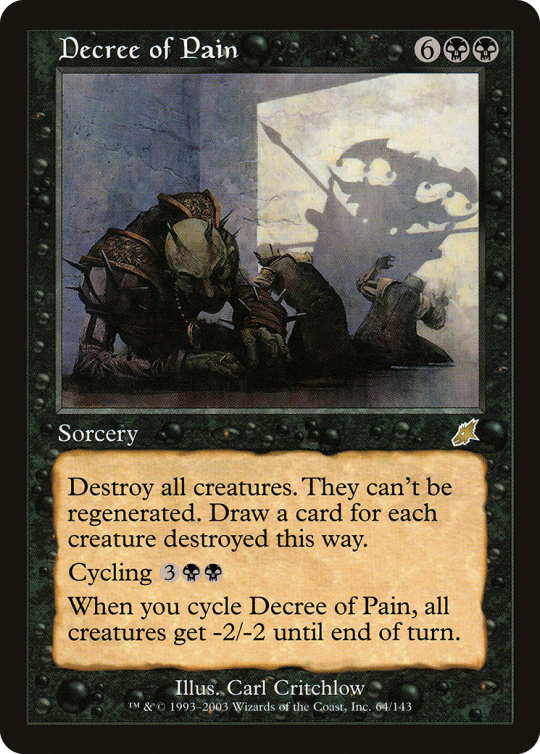
Red's mostly got board wipes that clear off small to mid-sized creatures. If you want to kill something big like an Inkwell Leviathan, you're gonna have to invest a ton of mana into an Earthquake or Starstorm. Although we did just get Chain Reaction in Rise of the Eldrazi, which I have high hopes for. Keep an eye out for that one!
The closest Blue's got to board wipes are mass-bounce cards like Evacuation, Inundate and Kederekt Leviathan. Expect to see more of these played at instant speed now that blue decks have a second Vedalken Orrery with the newly-printed Leyline of Anticipation. Green doesn't really have board wipes. It's got some Windstorm effects for clearing away flying creatures, but that's it. How many removal spells and board wipes should you have in a deck? Well, that can vary depending on your strategy, but I'd say that on average decks are playing 4 of each.
Threats and Win-Conditions
So far we've covered color-fixing, ramp, card draw, removal and board wipes: all things needed to get your deck off the ground and preventing your opponents from getting too far ahead. But now we need some haymakers to actually win the game! You have a lot of flexibility here; go raid your trade binder and pull out some big splashy creatures! Kaervek the Merciless, Hamletback Goliath, Stormtide Leviathan, Godsire! Keep an eye out especially for large creatures that have some effect when they enter the battlefield or die; the new Titan cycle from M11, for example, or something like Magister Sphinx. They get you value even if one of your opponents wipes the board the turn after you cast them. Likewise, giving your creatures haste is a big plus—Lightning Greaves is a must-have card for EDH.
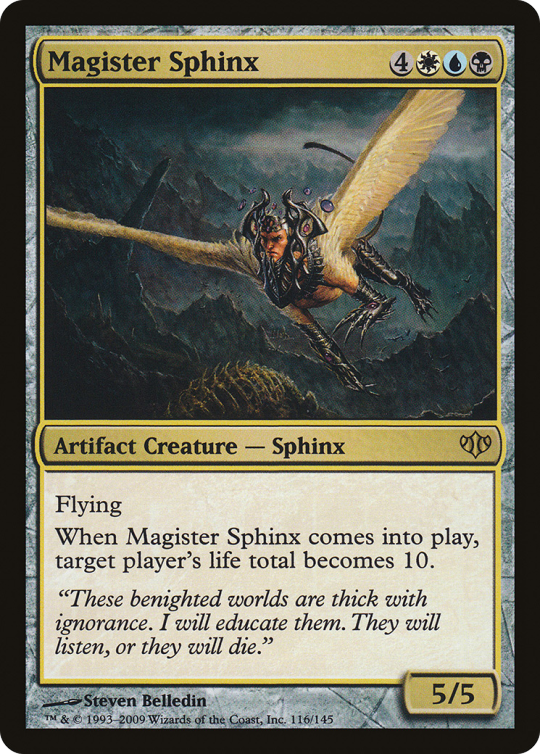
Large creatures are great, but you'll want a big sorcery or two to really bring the hammer down and finish the game. I've mentioned some of these already: Time Stretch, Insurrection, Tooth and Nail, etc. That, or have some sort of infinite combo that you can assemble that wins you the game. Kiki-Jiki + Pestermite is an obvious example, but there are lots of others that are too inefficient to see play in Extended or Legacy that you can use in EDH.
Thanks for reading
That's all from me! I hope this helps you have a fun time playing Elder Dragon Highlander! The difference in scale can take some getting used to, but once you do, you can get a ton of mileage out of your deck; since EDH is non-rotating and only a handful of cards from each new set get played in the format, you can comfortably go a year without making any upgrades to a deck and still have it be in fighting shape. The format moves very slowly. Hopefully this means that the advice in this guide, from 2010, will be applicable years and years from now! [DISCLAIMER: most of it isn't]
1 note
·
View note
Text
There seems to be some MTG events for pride month that are seemingly giving all legendary creatures Partner. So it got me and my EDH playgroup thinking on different deck ideas.
Personally, I thought this was the perfect opportunity for something I've been trying to make a playable deck for years: 5-Color Bant


It technically didn't have to be bant, but I've always wanted to make an EDH deck limited to 3 or less colors that was focused on cards you'd normally ever see in 5 color. Stuff like Domain, All Suns' Dawn, Spirit of Resistance, etc. Because a lot of that stuff can technically be run in monocolored decks, you just normally wouldn't because they need things usually only all found in 5-color, mainly basic land types and creatures outside of your decks colors.
HOWEVER, there are ways to give your lands basic land types outside of your colors AND there's spells that generate tokens that are a different color than themself. This deck seeks to use those niche ways to be able to use these cards, thought to be only 5-color-viable, to their full potential.
As you can see from the commanders, this deck mainly does this through Domain. I wanted to make better use of Converge/Sunburst, but the cards are just generally very weak in this format (as well as their not being many of them). However I was able to include a few of them as well as a few other strong cards that care about having creatures of different colors.
I've only played 1 game with it, but the deck performed decently. The main strategy is token beats with an alt wincon as back up. There's a decent amount of value engines that can help you dig for the domain and get there. It's in the right spot for me where its at my playgroup's power level or just a little below (I have too many decks that are just a little above). It's fun to play!
As for pride month, this deck also felt on theme because "rainbow". Although I don't know the characters particularly well, they are both women so that hits too. If I had to derive a cheesy message from this deck's theme, it would be that your identity is not an enclosed box. Gay men do not only know gay mean, NBs only only NBs, etc. You have friends waiting in more places than you think. This community is not defined by us being the same, but for us being different and looking out for one another.
0 notes
Text
Looked at the AC set coming to MTG this summer
I am hoping for a commander product bc I will buy one I s2g. I need an Altair deck.
Also the Ezio face card they're showing off is... kinda crazy. Like you need WUBRG to trigger his effect but that's not impossible. Until a lot of players get below 10 they don't really care about health in EDH. But he just insta-gibs someone if you have WUBRG and hits your face, and he's got menace so you have to always block with two or more creatures. Will it pop off every time? Probably not, he's gonna attract removal especially as a game goes on, but the times you do will be fucking awesome. Real Assassin shit.
Also he's just a pretty good five color commander in general. Menace and is a decent enough attacker especially if you wanna go voltron with him. Or if nothing else just have him as commander for a Oops All The Assassins deck since he's got that first ability where you can just pay 2 black to play any Assassin if Ezio hits you. And again Menace so it's likely early to mid game. Just flood the board with Assassins XDDDD
It looks like there are gonna be multiple versions of each Assassin kinda like in LotR which is gonna be cool. I saw two Ezio legendaries. So crossing my fingers for some interesting stuff and more Assassin/freerunning keyword synergies
1 note
·
View note
Text
What if EDH had Usage Tiers like Competitive Pokemon?
EDH Has A Problem EDH is a fanmade format for Magic: the Gathering and is the most popular way to play this 30 year old card game. Four players choose a legendary creature to build a deck around and then duke it out in a free for all. Magic is an old game with some cards being more powerful than others. EDH allows almost any card that exists to be played which is great until your casual deck…

View On WordPress
0 notes
Text
Phyrexia: All Will Be One Legends are Bad.
At least for Brawl. I’m looking at all of these legendaries for the new set and I gotta tell you. They’re powerful, but they’re bad. Most of them are not new effects. Several of the mythics are just different kinds of Panharmonicons. Meaning, I’m not building any new decks here. I’m slotting out a commander, slapping them in and saying, yeah sure. Why not? Having a doubler in the command zone seems pretty great. However, none of them actually build me a new option. They just power up my previous builds.
That’s not necessarily a bad thing. What IS a bad thing is that these cards didn’t bring us a new design space as brewers. No cool build-arounds. Just powerful effects that we already had, just now I can have it in my Command Zone. While that may rub you the right way, it doesn’t really get MY flow going. We’ve been getting set after set of commander focused legends and I feel that ONE did not deliver the same smattering of legends we’ve grown accustomed to. Of that matter, I’m actually quite glad. I don’t really want every set to have seven different unique commanders that I feel I NEED to built around.
I think Phyrexia: All Will Be One is finally a set that didn’t focus on the Commander players and gave all of the other formats cool new toys to play with. The EDH world has been getting all the love and I’m glad that we’re finally seeing some of that slack off and not getting busted, must-run commanders this set.
You may feel differently than I do. That’s okay. None of these commanders spoke to me, but you might have had some inspiration where I did not. I hope you’ll tell me about them and show me just why I should be building decks with the legends of Phyrexia: All Will Be One.
0 notes
Note
"Designing cards is different than determining functionality of the format." [In regards to the commander format]
But partner and planeswalkers that can be your commander HAVE messed with functionality of the format. The format was designed initially to use a single legendary creature, and now you've made 5 different options that intentionally changed that parameter (planeswalker commanders, partner, partner with, backgrounds, companion). I am not claiming whether those mechanics are bad or good, but you saying Wizards of the Coast has just made cards for EDH but hasn't messed with the functionality of the format feels disingenuous, because that isn't really the case. The line that's being drawn doesn't feel straight, it appears to be quite squiggly and faded at points; that, or it's a result of compromising what can and can't be changed.
Card designs impact formats. Absolutely. That wasn’t what I was saying. I was saying that we don’t make decision about how the format of Commander is structured.
For example, I can make all the hybrid cards in the world, but if the team who decides what’s legal in deck construction doesn’t allow a monowhite deck to play a white hybrid card, there isn’t anything I can do about that.
Card design impacts formats, but doesn’t determine the essence of how they work.
34 notes
·
View notes
Photo
unfortunately it does not have potential in graveyard based decks because there are so many better red/black discard outlets that you would never get close to considering this guy before running out of deck space (even in EDH, a singleton 100-card format). just go through this list and take your pick. notable picks include:

this dude completely blows Vishi boy out of the water as a creature at baseline, has a better activated ability in most contexts, and is monored + half the cost. Lol. Lmao, even.

if you really want a red creature discard outlet, this is your go-to. he actually saw Standard play for a while and is good outside graveyard decks as a curve-topper for aggro to cycle dead draws profitably.

if you want a 4-drop BR creature good in reanimator decks, you run this.

if you want a non-legendary 4-drop BR creature that lets you discard multiple times per turn, first off, why, that's a really specific request, but secondly, you would run this. thirdly, isn't it cool how 3 out of these 4 cards are minotaurs? i think it's cool.
anyways the tl;dr is that there is literally no competitive deck that would choose to run this card. the only thing it has going for it is that it's one of a handful of creatures whose name is exactly the same as their creature type. they didn't even name this mf

Viashino Skeleton
Underneath the Dregscape lay the remains of creatures long extinct from Grixis.
Artist: Cole Eastburn TCG Player Link Scryfall Link EDHREC Link
#lmfao wait i just realized chainer gives himself haste if you cast him from the command zone#i am assuming you meant “good in graveyard play decks” as in “good as a discard outlet”#if you meant “good as a reanimator target”... whew lad......
100 notes
·
View notes
Text

That sad moment when Shoving Match needs to be taken out of a deck.
22 notes
·
View notes
Text
Aminatou, the Fateshifter (Fall 2022 Update)

Hey everyone! It’s been a long while, but today I’ve got an update on my very best commander deck: Aminatou, the Fateshifter. When I first bought her precon not quite a year after it came out, I quickly stuck her into my collection and stripped the deck for parts. After a while though, when my old Vona deck grew old, I started looking into a new angle. Thus, the first iteration of Aminatou (or at least my version of it) was born.
She started as an amalgamation of a flicker deck (based around her -1 ability) and an old superfriends angle I’d been working on for some time. This origin remains a visible part of the deck’s identity even today, with a total of eight ‘walkers and nearly half a dozen planeswalker support cards. Today, we’re looking into the absolute 15 must-have cards for building her yourself. Though these cards a numbered for the sake of this list, the number assigned is entirely arbitrary and not related to the card’s relevance to the deck relative to each other.
#1: Felidar Guardian Card transcription: 3W, 1/4 Cat Beast. When it enters the battlefield, exile another permanent you control, then return it to the battlefield under its owner’s control. Those of you who played Standard during the early days of Aether Revolt will recognize this cat as the pivotal partner of the Saheeli Rai infinite cats combo, which functioned by using Felidar Guardian’s enter-the-battlefield effect to essentially “reset” Saheeli, allowing her to -2 to create a duplicate Felidar, with each duplicate gaining haste and repeating the process. It does the former with Aminatou, using her -1 to flicker the Felidar and then Felidar flickering Aminatou in turn. Combine this with Panharmonicon or Oath of Teferi for infinite flickers as either Aminatou flickers something else before flickering Felidar (Oath) or Felidar flickers Aminatou and something else when it enters (Panharmonicon). Add in anything that draw cards and you can have infinite mana and draw with which to seek your win condition. Alternatively, these two with either Vela the Night Clad or Corpse Knight allows you to win on the spot if an opponent can’t stop you.
#2: Panharmonicon Card transcription: 4, Artifact. If an artifact or creature entering the battlefield triggers a permanent you control, it triggers that permanent a second time. Panharmonicon has gained a sort of infamy in EDH, and for good reason. It can double any enter-the-battlefield trigger, from Acidic Slime to Gray Merchant of Asphodel. As stated above, it’s a key combo piece for Aminatou.
#3: Oath of Teferi Card transcription: 3WU, Legendary Enchantment. When it enters, exile another permanent you control until end of turn. and You can activate loyalty abilities of each of your planeswalkers twice each turn. While much more niche to planeswalker decks, Oath of Teferi is an absolute powerhouse, though it must be included in a deck that already runs both blue and white. Activating each of your planeswalkers twice each turn is amazingly powerful in a deck that has both a planeswalker commander and seven others, and with Aminatou specifically it essentially functions as a second Panharmonicon.
#4: Rings of Brighthearth Card transcription: 3, Artifact.Whenever you activate a non-mana ability, you may pay 2 to copy that ability. While the constant cost of 2 mana for each ability being copied (which becomes more pressing once Oath of Teferi hits the board), some of those abilities are certainly well worth the cost. If you choose to run Basalt Monolith (which will not be appearing on this list), Rings of Brighthearth can essentially grant you infinite colorless mana, paying for all the planeswalker ability copies.
#5: Callous Bloodmage (honorable mention: Charming Prince) Card transcription: 2B, 2/1 Vampire Warlock. When it enters choose one: Create a 1/1 Pest; You draw a card and lose 1 life; or Exile target player’s graveyard. Transcription (honorable mention): 1W, 2/2 Human Noble. When it enters choose one: Scry 2; Gain 3 life; or Exile another creature you own until end of turn. Charms have been historically appreciated for their flexibility, and modal creatures are essentially charms with repeatable effects in flicker decks. While both Callous Bloodmage and Charming Prince are amazing, our list will focus primarily on the latter. The Bloodmage’s token production is negligible, however the latter two options both have powerful options: drawing a card is always great and the third exiles an entire graveyard, severely hindering a reanimator deck (popular examples include Meren and Muldrotha) on its own. With the option to choose a different effect every time it enters, you have a one-card toolbox with a gadget for multiple occasions.
#6: Dakkon, Shadow Slayer Card transcription: WUB, Legendary Planeswalker. It enters with loyalty equal to the number of lands you control. +1: Surveil 2. -3: Exile target creature. -6: Put an artifact from your hand or graveyard into play. In the initial version of this deck, this variable slot was occupied by the 2nd Zendikar block Ob Nixilis. Dakkon, however, fills your needs at a lower mana value, has higher average starting loyalty, and can easily reanimate your artifacts (which, as you’ve no doubt noticed, there are quite a few that this deck loves). Even when you aren’t using his ult, his removal option is more powerful than Ob’s and gaining card selection rather than draw is a negligible difference.
#7: Liliana, Death’s Majesty Card transcription: 3BB, Legendary Planeswalker. 5 loyalty. +1: Mill 2 cards and make a 2/2 zombie. -3: Reanimate a creature from your graveyard. It becomes a zombie. -7: Destroy all non-zombie creatures. While her ultimate is largely irrelevant, Lili’s -3 ability is a substantial boon, allowing you to reanimate creatures while dodging expensive or color-intensive mana costs. Her plus is also moderately relevant, creating a blocker for herself while also digging for something to reanimate.
#8: Omen of the Dead Card transcription: B, Enchantment. Flash. When it enters, return a creature from your graveyard to your hand. This simple common from Theros 2 is easy to skip over, and that’s where its power lies. For 1 mana as an instant, you can recur a creature back to your hand, and your various flicker cards can abuse it to grab more creatures from your graveyard. Because it’s so simple, seemingly low-power, your opponents often won’t think to remove it at first. It’s just an ordinary common, right?
#9: Omen of the Sea Card transcription: 1U, Enchantment. Flash. When it enters, scry 2 and draw a card. The blue omen is good for essentially the same reason as the black. It’s cheap, it has flash, and it provides a moderate benefit. Really, the only one of this cycle that isn’t worth playing in Esper is the white one.
#10: Oath of Jace Card transcription: 2U, Legendary Enchantment. When it enters, draw three and discard two. and At the beginning of your upkeep, scry equal to the number of planeswalkers you control. This deck will likely want to run most, if not all, of the Gatewatch oaths it can. Oath of Jace, however, is a particularly powerful card advantage piece. As you accumulate planeswalkers on your board, it can scry deeper into your deck, and when in doubt you can just flicker it to immediately draw three. Discarding the two isn’t much of a problem with the amount of recursion that naturally fits into the deck.
#11: Restoration Gearsmith Card transcription: 2WB, 3/3 Human Artificer. When it enters, return an artifact or creature from your graveyard to your hand. Restoration Gearsmith’s effect is simple recursion, much like what you have plentiful access to. What makes it significant, however, is its ability to grab both creatures and artifacts, allowing it to retrieve Mulldrifters and Panharmonicons alike.
#12: Cloudblazer (honorable mention: Mulldrifter) Card transcription: 3WU, 2/2 Human Scout. Flying. When it enters, gain 2 life and draw two cards. Transcription (honorable mention: 4U, 2/2 Elemental. Flying. When it enters, draw 2 cards. You can cast it for 2U to sacrifice it immediately upon entering. Perhaps one of your best cards for draw (second to Oath of Jace), Cloudblazer’s ability to gain life as well helps buy more time with which to draw and play win conditions. Mulldrifter is nearly identical, but it trades the life gain for a cheaper casting option.
#13: Yorion, Sky Nomad Card transcription: 3HH (Hybrid: WU), 4/5 Legendary Bird Serpent. Flying. When it enters, exile any number of other nonland permanents you control until end of turn. While not a powerful combo piece like Felidar Guardian or a draw engine like Oath of Jace, Yorion certainly brings his own might to the table. On entering, you can use him to re-trigger the enter-the-battlefield effects of any permanent you control other than a land, and he can reset the loyalty of any of your planeswalkers. Since his effect also triggers on his own entry, you can flicker him to flicker your entire board at once.
#14: Gray Merchant of Asphodel Card transcription: 3BB, 2/4 Zombie. When it enters, each opponent loses life equal to your devotion to black. You gain life equal to the total life lost this way. As many of you who’ve played commander extensively know, Gray Merchant of Asphodel (or Gary) can be powerful even outside of mono black decks, making it the most versatile of the devotion cards. Besides Vela or Corpse Knight, Gary is your most reliable win condition, blasting each opponent from anywhere between three and eight life every time it enters and gaining you a bunch of life of your own. In a flicker deck, that difference adds up very quickly.
#15: Sanctum of Eternity Card transcription: Land. Tap: Add one colorless mana. 2, Tap: Return a commander you own from the battlefield to your hand (only during your turn). While it certainly feels weird finishing this list off with a land, Sanctum of Eternity deserves it. With the deck centering around Aminatou’s -1 ability, she’ll run out of loyalty very quickly; Sanctum allows you to bounce her back to hand before you spend her last loyalty counter, so you can replay her fresh to keep going.
She may have been a small child for the past four years, but Aminatou has grown a lot since I first built her deck. While the core identity hasn’t changed, she’s improved her approach significantly, and remains a blast to play even next to many commanders of today. So whether you want to have fun with my take on Aminatou or are simply looking to inspire your next brew, I hope to see you all on the battlefield.
8 notes
·
View notes